Traditional Dresses Of Indian States
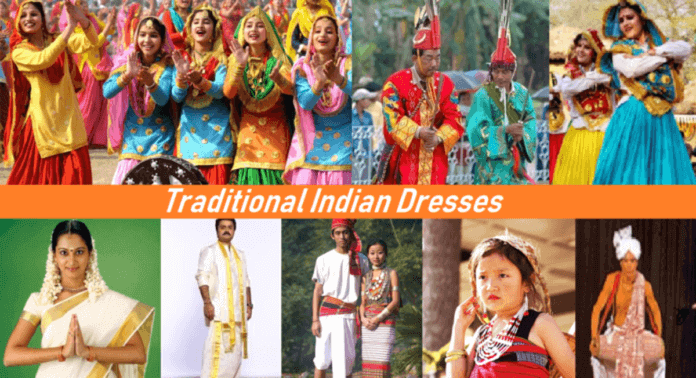
India is the land of “Unity in diversity“, it harbors various cultures, traditions, religions, castes, languages, races, and ethnic groups. Diversity means the difference in people’s race, religion, language, and traditional dresses, however, Unity is being together as an Indian Society.
India has 28 states and 8 union territories, each having a different culture and civilization. Each state has its own traditional clothes and fashion culture. Here we are presenting a collection of dress codes of 28 Indian states.
1. Andhra Pradesh:

Andhra Pradesh is a southern state in India. It shares its boundaries with Telangana, Chhatisgarh, and Odisha with the Bay of Bengal in the east. Called the “Rice Bowl of India” as they grow rice in plenty.
Andhra Pradesh is regarded as the Kohinoor of India for its famous weaving and dying industry. The traditional wear of Andhra Pradesh is much the same as in other southern Indian states. Men usually wear kurta and dhoti, while lungis are also worn with a kurta. Muslim men wear pajamas with kurta in place of the dhoti.
The women of Andhra Pradesh wear saree and they are original handloom sarees, young women wear Langa Voni. For marriage ceremonies, the bride wears silk sarees which are red and decorated with gold plating, while the bridegroom wears kurta and full-length dhoti.
With the influence of western culture people of urban areas wear western clothes in the office/workplace. women prefer to wear salwar kameez or western clothing rather than saree. Youth and kids wear pants, shirts, and t-shirts.
2. Arunachal Pradesh:
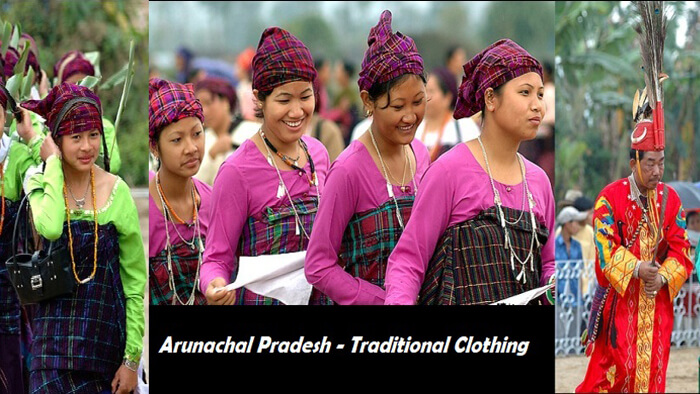
Arunachal Pradesh is the north-eastern state of India bordering with Nagaland and Assam to the south, while Myanmar to the east, Bhutan in the west, and China to the north. Their dresses are very vibrant, bright and their myriad patterns vary with different tribes. The Attire of Arunachal Pradesh is remarkable and famous all over India.
The Monpas, the Buddhist community are famous for their skull cap, women wear sleeveless chemise with a long jacket. There is a narrow strip of cloth that they tied around their waist to keep chemise tied in place.
Bamboo earrings and silver earrings are very common. Females of tribes residing in the lower Kamla valley have a very peculiar costume. They tie their hairs in a knot just above their forehead.
Men wear sleeveless material made of silk with two edges pinned to the shoulder area. The clothing is knee-long and its hallmark is the skull -cap smeared with hairs of yak.
Tang’s tribe people adorn costumes which is the style of Burmese. Men wear sleeveless shirts and lungi of green color with white, red, and yellow yarn. Women wear a woven petticoat with a blouse. Miji women wear long cloaks and big earrings.
3. Assam:
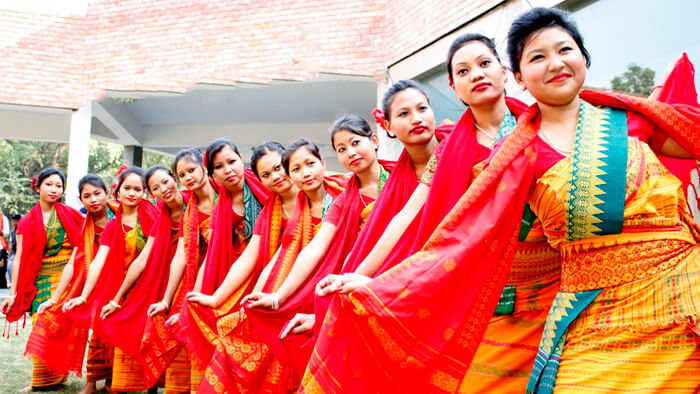
Assam is surrounded by seven northeastern states in India. The traditional dress for men is dhoti-kurta while for women they wear ‘Mekhela-Chador‘ or ‘Riha-Mekhela’.
This traditional dress is made from the prestigious ‘Muga Silk‘ which is the peculiarity, as well as the pride of Assam. They also wear ‘Dokhora’ and dresses like a salwar suit, sari, etc. Women feel proud to wear handloom products, especially Mekhela chador, during special occasions like weddings and festivals like Bihu and Saraswati puja.
The women of the Bodo Tribe wear Mekhela paired with a chadar while women of the Thai Phake Tribe wear a striped girdle called Chiarchin. The traditional dress worn by the menfolk of Assam is ‘Suria’ or ‘dhoti’ and ‘kameez’ or ‘shirt’ and over it, a chadar known as ‘Seleng’ is spread.
4. Bihar:
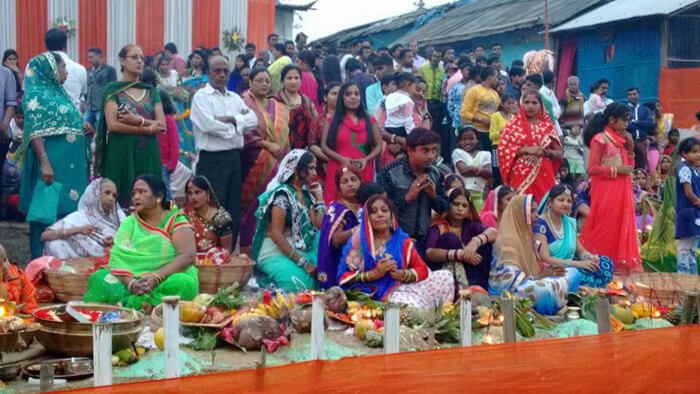
The traditional dress of the Bihari people includes the dhoti-mirjai or the kurta for men and Saree for women. The effects of western culture have also affected the lives of the people of Bihar where women prefer to wear saree or Kameez-Salwar.
The saree is worn in the “Seedha Aanchal” style traditionally. Western shirts and trousers are also becoming very popular in both the rural and urban male population.
5. Chhattisgarh:
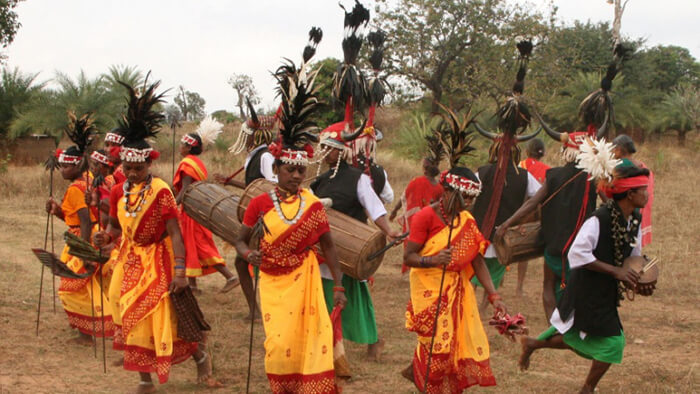
Chhattisgarh is a central state of India. It’s rich in culture, legacy, and enormous diversity of various ethnic sets. Chhattisgarh tribes wear bright and colorful fabrics. They love to wear jewelry on their neck. Chhattisgarh traditional women’s clothing is a Kuchhora style saree. Their saree are knee-length.
Men in tribal groups wear dhotis and headgears like cotton turbans. The fabrics used are linen, silk, and cotton and they are usually painted with molten wax. Their tie and dye technique used in fabrics is called Batik.
6. Goa:
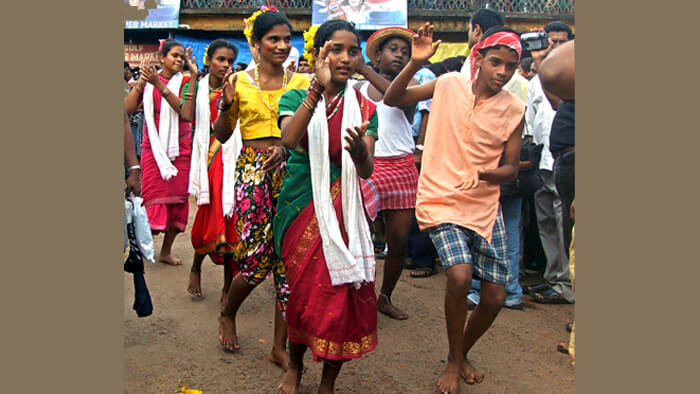
Goa the land of beaches is immensely popular among tourists. The women of goa wear Nav Vari which is a 9-yard saree studded with precious stones and worn with beautiful accessories.
Other women’s traditional costumes are ‘Pano Bhaju‘. The men in goa wear brightly colored shirts, half pants, and bamboo hats.
7. Gujarat:
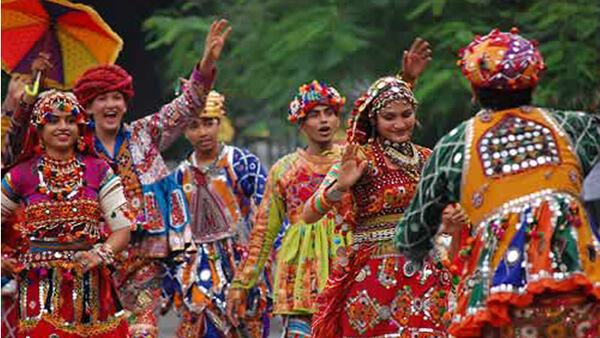
The traditional dress of Gujarat is unique in its own way. The women wear Chaniya choli, Chaniya is a colored petticoat embroidered with glass pieces while choli is a colored piece of coarse cloth covering the upper body.
Along with the colorful attire, women adorn themselves with sparkling ornaments. Men wear Chrono & Kediyu, but nowadays instead of wearing traditional outfits, people dress in modern apparel.
8. Haryana:
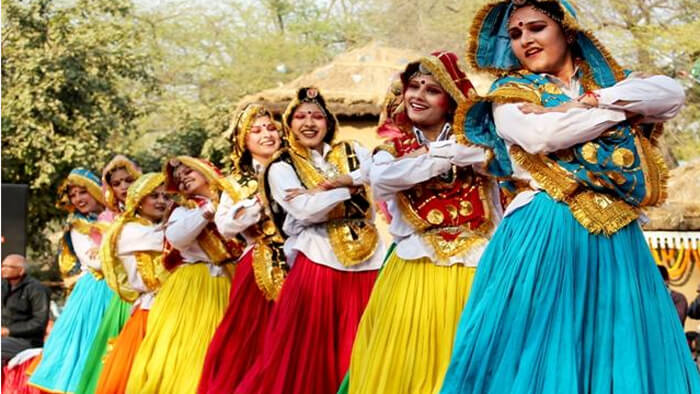
Women love to wear colorful dresses. Their basic trousseau includes ‘Damaan’, ‘Kurti’ & ‘Chunder’. ‘Chunder’ is the long, colored piece of cloth, decorated with shiny laces, meant to cover the head and is drawn in the front like the ‘pallav’ of the saree. Kurti is a shirt like a blouse, usually white in color. The ‘Daaman’ is the flair ankle-long skirt, in striking colors.
The men generally wear ‘Dhoti’, the wrap-around cloth, tucked in between the legs with a white-colored kurta worn atop it. ‘Pagri’ is the traditional headgear for men, which is now worn mainly by the old villagers. All-white attire is a status symbol for men.
9. Himachal Pradesh:
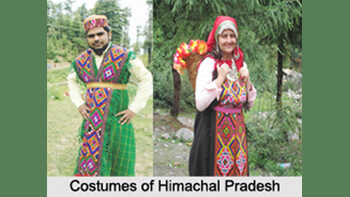
The people of Himachal Pradesh mostly wear woolens as its best suited to the climate. Scarves and shawls are ubiquitous with the women while the men can be found in various types of Kurtas and the typical Himachal cap.
The Rajput males comprise starch stiffened Kurtas and body-hugging ‘Churidaars’. The females of this group apparel themselves little conventionally costumes like kurtas (shirt-like oriental blouse), Salwar, Ghaghara (Indian long skirts), choli (blouses or tops), and Rahide (headscarves decked with golden periphery).
10. Jammu and Kashmir:
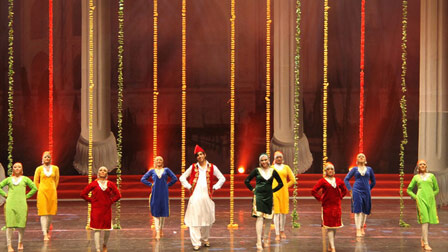
The Pheran is a prominent attire for Kashmiri women. The Pheran is worn by women usually has Zari, embroidery on the hemline, around pockets, and mostly on the collar area. Ladies prefer a suit and Burgha in summer and Pheran are preferred in autumn.
The typical dress of a Kashmiris man both Hindu and Muslim is Pheran, a long loose gown hanging down below the knees. The men wear a skullcap, a close-fitting shalwar (Muslims), or churidar pajama (Pandits).
11. Jharkhand:
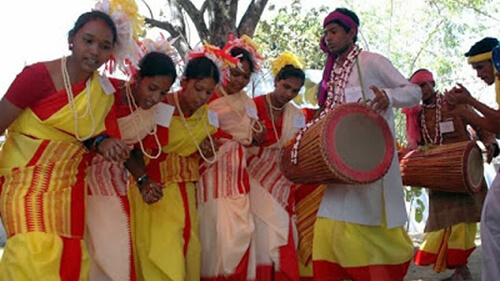
On auspicious occasions in Jharkhand like Pooja Text or Wedding Vagera, people wear their local traditional clothes like kurta, pajamas, lehenga, saris, dhoti, sherwani, etc. Tussar silk sarees are made in Jharkhand, known for their elegance and unique look. Tribal women wear Parthan and Panchi.
But nowadays people have moved on from wearing traditional dresses to adopt western culture garments. People here started wearing jeans, t-shirts, shirts, lower, jackets, belly, blazer suits, etc.
12. Karnataka:
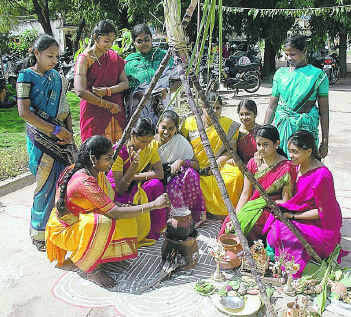
The traditional clothing for women in Karnataka is a saree made of silk. Karnataka is known as the Silk hub of India as a wide variety of silk can be found here. Mysore and Bangalore are mainly famous for their silk industries.
Kanchipuram or Kanjeevaram silks of Karnataka are very famous all over India. The traditional dress for men in Karnataka is Lungi, worn under the waist below a shirt. Mysore Peta is a conventional headdress for men.
13. Kerala:
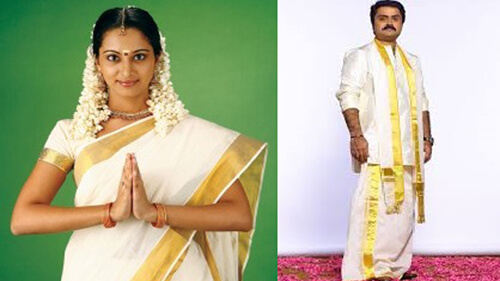
The traditional clothing of women in Kerala is the ‘Kerala Saree’ or the Mundum Neriyathum. This is in two pieces, one is draped on the lower part of the body and then the neriyathu is worn over a blouse.
The men of Kerala tend to be more conservative than women and stick to tradition. Mundu is worn on the lower part of the body and is a long garment tucked around the waist, it reaches their ankles. Many prefer to wear it above their waist and the higher caste drape a cloth over their shoulders.
14. Madhya Pradesh:
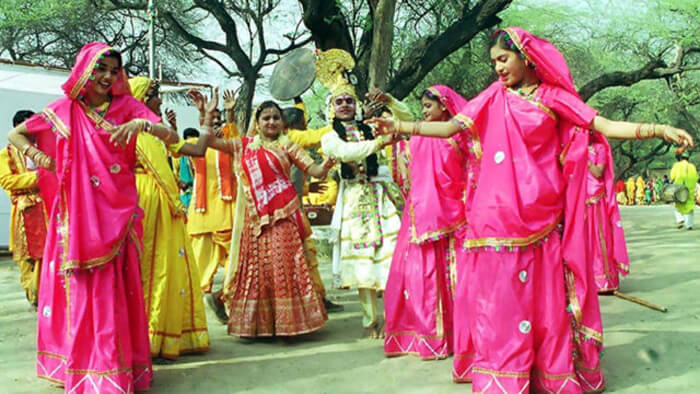
Women of Madhya Pradesh wear Lehenga and Choli with an Orni or Lugra, which is an additional cloth wrapped around their heads and shoulders. Whereas the male community wears dhoti along with Bandi, which is a kind of jacket and headgear.
15. Maharashtra:
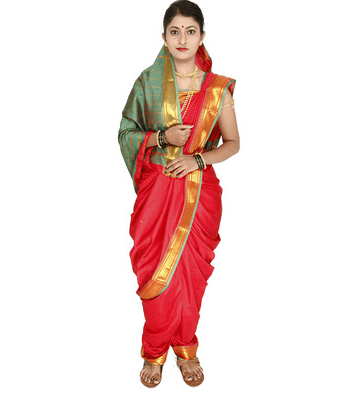
Traditional clothes for Maharashtrian males include the dhoti, also known as dhotar, and pheta, while a choli and nine-yard saree locally known as Nauwari Saadi or Lugda are for women.
Traditional clothing is famous in rural areas while traditional people from cities also wear these clothes. These clothes are worn by Maharashtrians while performing various festivals.
Suggested Read: Saree – the dress if Indian women
16. Manipur:
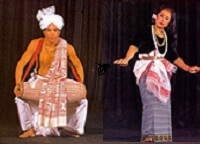
Innaphi and Phanek are the Manipuri traditional dress for women in Manipur. A shawl or dupatta called Innaphi and a skirt called a Phanek, which are wrapped around the chest. The dress is woven with a hand in horizontal lines.
Men wear dhotis which is four and a half meters long. These are wrapped around the waist and legs and knotted at the waist, and paired with smart jackets or bundis. Headgear is a white pagri or turban.
17. Meghalaya:
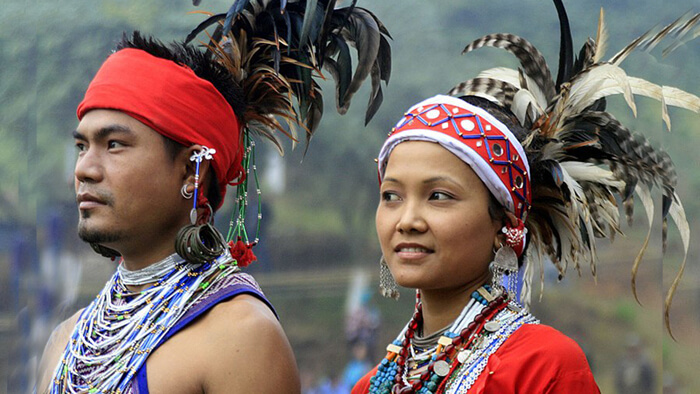
Meghalaya has three main tribes Khasi, Jaintias, and Garos, and the traditional dress of each tribe is peculiar. The traditional Khasi female dress is called the Jainsem or Dhara, both of which are rather elaborate with several pieces of cloth, giving the body a cylindrical shape. The traditional Khasi male dress is a Jymphong, a longish sleeveless coat without a collar, fastened by thongs in front.
A Garo woman also wears a blouse and an unstitched ‘lungi’ like cloth which is known as ‘Dakmanda.’ It is fastened around the waist. Both Garo men and women enjoy adorning themselves with ornaments. The women of the Jaintia tribe wear a velvet blouse along with a sarong called ‘Thoh Khyrwang’ which is wrapped around the waist.
18. Mizoram:
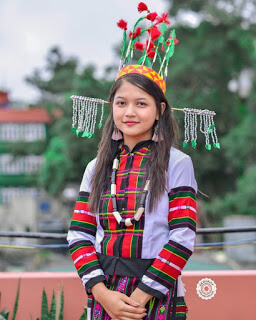
Mizo women love to wear Puran, which is the most favorite dress in Mizoram. The lively color and the exceptional designs and fittings made this outfit superb. Puanchei, the gorgeous dress of Mizo girls is a must during weddings and festivals such as ‘Chapchar Kut’ and ‘Pawl Kut ‘. The shades in the attire are black and white. The black portion of the textile is originated from some kind of synthetic fur. Kawrchei is a fabulous blouse for Mizo girls. That also is hand-woven and cotton material.
Mizo men drape themselves in an almost 7 feet long and 5 wide cloth piece. In the cold season, some additional cloth is used, one on top of the other, along with a white coat, comes down from the throat enveloping the thighs. White and red bands, stuffed with designs adorn the sleeves of these coats.
19. Nagaland:
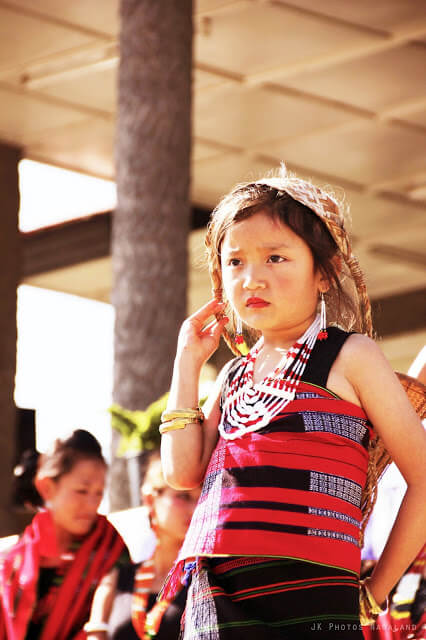
Naga has Red as the most primary color in costumes. The traditional dress material and costume of the Angami men are kilt and wrapper, while the women use a skirt, shawl, and apron. Most of the women, unlike men, wear traditional dresses. A kilt looping down to the knee is a man’s typical waist dress which is of light blue color.
A women’s skirt is a sheet of cloth that is used by rolling it along the waist and which loops down to cover legs. Neck ornaments are mainly strings of beads, shells, boar’s tusks, and horns.
20. Odisha:
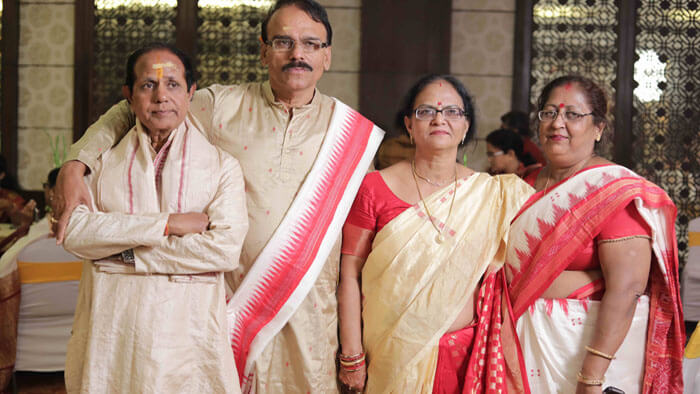
In Odisha western-style dress has gained greater acceptance in cities and towns among men, although the people prefer to wear traditional dresses like Dhoti, Kurtha, and Gamache during festivals or other religious occasions. Women normally prefer to wear the Sari (Sambalpuri Sari) or the Shalwar kameez; western attire is becoming popular among younger women in cities and towns.
21. Punjab:

The traditional dress for women is the salwar suit which replaced the traditional Punjabi ghagra. The Punjabi suit is made up of a kurta or kameez and a straight-cut salwar. The Patiala salwar is also very popular in India.
The traditional dress for Punjabi men is the kurta and tehmat, which is being replaced by the kurta and pajama, especially the popular muktsari style in India. It is called muktsari style because it originates from Muktsar in Punjab.
Suggested Read: Salwar Kameez
22. Rajasthan:
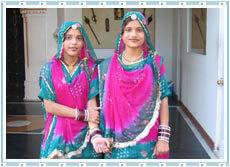
Traditionally men wear dhotis, kurta, angarkha, and paggar or safa (kind of turban headgear). Traditional Chudidar pajama (puckered trousers) frequently replaces dhoti in different regions. Women wear ghagra (long skirt) and Kanchi (top). However, the dress style changes with the lengths and breaths of vast Rajasthan. Dhoti is worn in different ways in Marwar (Jodhpur area) or Shekhawati (Jaipur area) or Hadoti (Bundi area).
23. Sikkim:
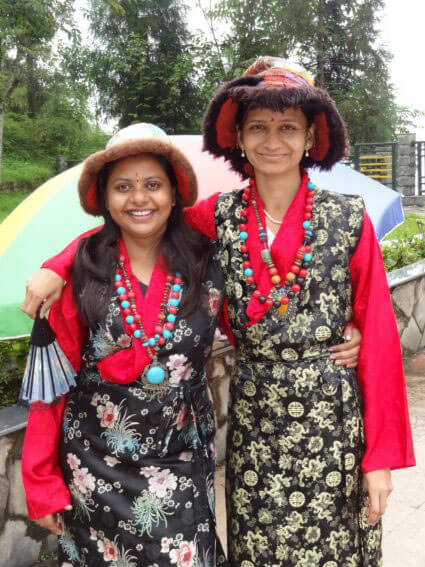
The traditional costume of Lepcha women is called Dumvum or Dumdyam. It is an ankle-long costume worn like a sari. Another costume worn is Nyamrek which is beautifully attached to the blouse. another community Bhutia wears Bakhu or Kho costumes. It is a loose, cloak-style garment that is fastened at the neck on one side and near the waist with a silk or cotton belt.
Male members wear loose trousers under the Kho. The traditional outfit is complemented by embroidered leather boots by both men and women.
24. Tamil Nadu:
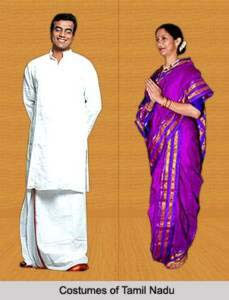
In Tamil Nadu women wear sarees. The young girls wear full-length short blouses and shawls, this style of wearing is called Pavada, which also known as a half sari. Now, most of the women in cities are wearing Salwar Kameez, Jeans, and Pants.
The Tamil Nadu men are usually seen dressed in Lungi along with a shirt and Angavastra. The traditional Lungi originated in the South and it is simply a short length of material worn around the thighs like a Sarong. A Dhoti is a longer Lungi but with an additional length of material pulled up between the legs.
25. Telangana:

Telangana is rich in cotton production and its innovative plant dye extraction history stands next to diamond mining. Traditional Women wear a sari in most parts of the state. Langa Voni, Shalwar kameez, and Churidaar are popular among unmarried women.
Some of the famous sarees made in Telangana are Pochampally Saree, Gadwal sari. Male Clothing includes the traditional Dhoti also known as Pancha.
26. Tripura:

The dress for women for the lower half of the body is called Rigwnai in Tripuri and for the upper half of the body, the cloth has two parts Risa and Rikutu. Risa covers the chest part and the rikutu covers the whole upper half of the body. Nowadays risa is not worn, instead, a blouse is worn by most Tripuri women because of convenience.
The male counterpart used to wear ‘rikutu’ for the loin and ‘kamchwlwi borok’ for the upper part of the body. But in the modern age, very few people are wearing these dresses except in the rural Tripura and working class.
27. Uttar Pradesh:
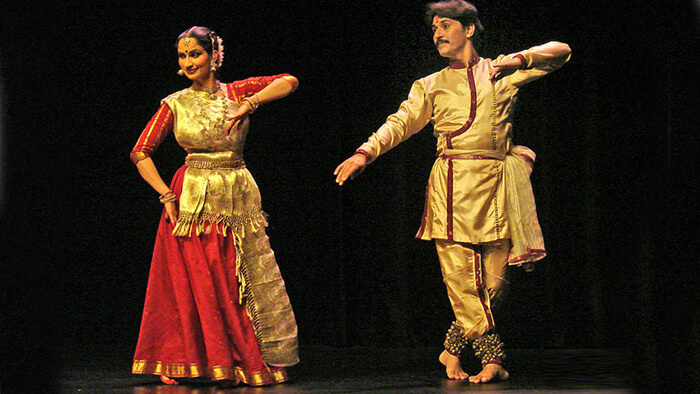
The costume of Uttar Pradesh is a very typical one where the women are clad in their saris adorned by the golden jewelry and Mangal Sutra (a chain with a pendulum gifted by the groom to his bride) worn by married women while the men look clad in dhoti kurta or kurta pajama. Toe rings are common all over Uttar Pradesh among married woman folks.
28. Uttarakhand:

Dress for females is Ghagara, Aagari, Dhoti Kurta, Bhotu. While for males churidar pajama, Kurta, Gol topi or Jawahar topi, Bhotu, Dhoti, Mirje are worn.
Dhoti or Lungi is worn by men as a lower garment, with kurta as the upper garment. Men also like to wear headgear in Garhwal.
29. West Bengal:
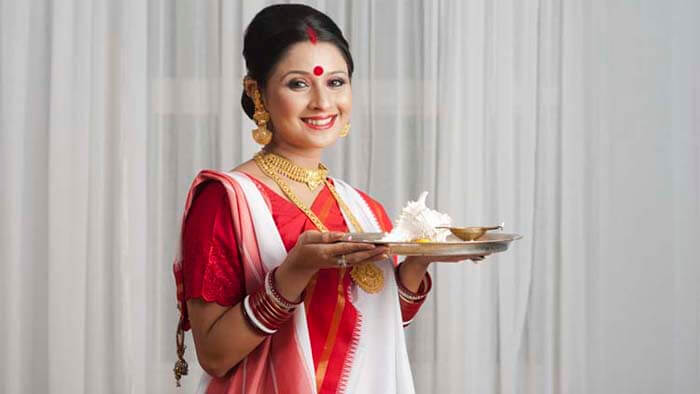
Bengali women traditionally wear the sari and shalwar kameez. The traditional dress for men like a dhoti, Panjabi, kurta, sherwani, pajama, and lungi are seen during weddings and major festivals.
But nowadays people don’t wear traditional dresses rather than they like to wear comfortable western dresses.
Suggested Read: Languages in India State






